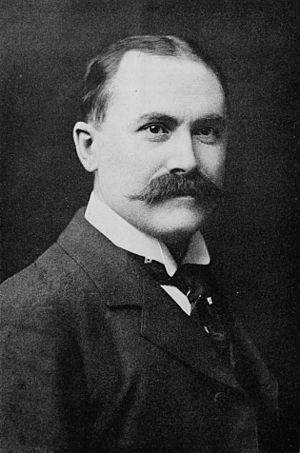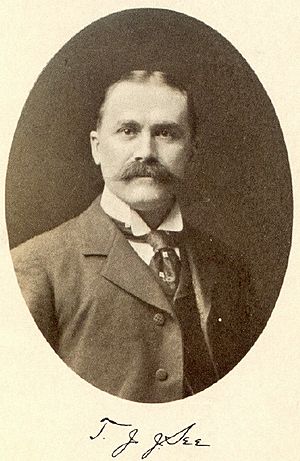Thomas Jefferson Jackson See facts for kids
Quick facts for kids
T. J. J. See
|
|
|---|---|

Portrait of T. J. J. See
|
|
| Born | February 19, 1866 |
| Died | July 4, 1962 (aged 96) |
| Nationality | American |
| Alma mater | University of Missouri |
| Scientific career | |
| Fields | Astronomy and Mathematics |
| Institutions | Instructor, Department of Astronomy, University of Chicago, Chicago, Ill., Astronomer, Lowell Observatory, Flagstaff, Ariz., Astronomer to Naval Observatory, Mare Island, Calif. |
Thomas Jefferson Jackson See (born February 19, 1866 – died July 4, 1962) was an American astronomer. He developed many theories about space and physics, but these ideas were later shown to be incorrect. Throughout his career, he faced problems like copying other people's work and arguing with others. He even spoke out against Einstein's theory of relativity. He lost his job at two different observatories. Later, he worked at a naval base in California until he retired.
Early Life and Education
Thomas J. J. See was born near Montgomery City, Missouri. He went to the University of Missouri and finished his studies in 1889. He seemed like a brilliant student, earning high honors and becoming the top student in his class. He even won an award for a paper he wrote about astronomy.
However, there were some issues. His graduation speech was copied from another student. Also, his award-winning astronomy paper was not his original work; it was taken from earlier research by Sir George Darwin. These early problems, along with arguments he had at the university, showed a pattern that would follow him throughout his career. Despite this, See went on to the University of Berlin in Germany. He earned his PhD in mathematics in 1892. With this advanced degree from Europe, See returned to America with a lot of promise for a bright future.
Scientific Career and Challenges
See focused his scientific work on studying binary stars. These are systems where two stars orbit each other. He was especially interested in figuring out their orbits. His first job was at the University of Chicago, where he worked as an instructor.
In 1896, See left Chicago because he didn't get a promotion he wanted. He then worked at Lowell Observatory. But he was fired in 1898 because he was often arrogant and difficult with his co-workers. His overconfidence and carelessness sometimes led to mistakes in his scientific findings. After leaving Lowell, See joined the United States Naval Observatory in 1898.
It was at the Naval Observatory that some of his earlier work caused big problems. In 1895, See had studied a well-known binary star called 70 Ophiuchi. He thought he saw small changes in the star's movement. He believed this meant there was a third, unseen object affecting it. He published his findings. However, in 1899, another scientist named Forest R. Moulton looked at See's idea. Moulton showed that a system with three objects like See described would be unstable. This meant it was very unlikely to exist. See became very angry and wrote a harsh letter to the science journal. The journal published an edited version of his letter, but then they banned him from publishing there again.
See found himself disagreeing more and more with other astronomers. He had a difficult time in 1902. He taught for a short time at the United States Naval Academy. Then, he was moved to a naval base at Mare Island, California. He was put in charge of the time station there, and he stayed in that role until he retired in 1930.
In 1910, See published a very long book called Researches on the Evolution of the Stellar Systems, Vol. II, The Capture Theory of Cosmical Evolution. In this book, he said his goal was to "brush aside the erroneous doctrines heretofore current," meaning he wanted to get rid of all the wrong ideas that had been believed for a long time.
In 1913, a newspaper publisher and amateur astronomer named William Larkin Webb wrote a book about See. Webb was a big admirer of See. Many people thought See himself had secretly written the book. This book made many wild claims, like saying See was "the greatest astronomer in the world." These exaggerated claims actually hurt See's reputation even more among other scientists.
See is also known for his strong belief that the bright star Sirius used to be red. Ancient observers sometimes described Sirius as red. But modern science shows Sirius is white, and it's almost impossible for it to have been red in the past. This is called the Red-Sirius controversy. See wrote many papers about this, attacking anyone who disagreed with him. He ignored many ancient writings that described Sirius as blue or white. His focus on this unusual idea made him seem even more out of step with mainstream astronomy.
During his years at Mare Island, See tried to become famous by discovering new laws of nature. He published many ideas about how the solar system formed, the size of the Milky Way, and what causes sunspots and earthquakes. He also wrote a lot about the Aether. This was an old idea about an invisible substance that filled space. See thought it explained all forces in the universe.
He also strongly criticized Einstein and his theory of relativity. However, Einstein mostly ignored See's attacks, and the scientific community also didn't pay much attention to See's criticisms of relativity.
Many of See's papers are kept in the Library of Congress.
See also
 In Spanish: Thomas Jefferson Jackson See para niños
In Spanish: Thomas Jefferson Jackson See para niños


